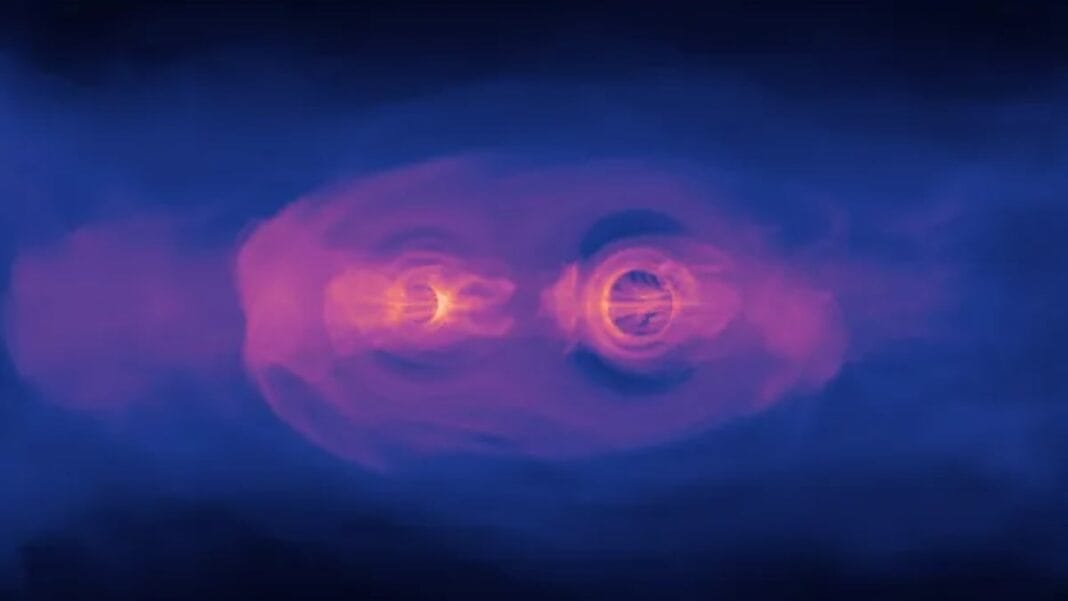Supermassive Black Holes: A Cosmic Mystery Unveiled
Astronomers have long been puzzled by the existence of supermassive black holes detected during the universe’s earliest phases, just a few hundred million years after the Big Bang. Recent findings suggest these cosmic giants may have originated as primordial “seeds” during the Big Bang itself, shedding light on the emergence of these massive entities in the universe’s infancy.
Early Observations Challenge Current Theories
As per a study submitted to the Journal of Cosmology and Astroparticle Physics, the James Webb Space Telescope (JWST) has identified supermassive black holes in galaxies formed shortly after the Big Bang. These black holes, ranging from hundreds of thousands to billions of times the mass of the Sun, appear to have developed faster than current astrophysical models predict.
Conventionally, black holes form from the remnants of massive stars. However, the timeline observed with JWST poses challenges, as this process would require stars to form, die, and merge at an extraordinarily accelerated rate.
Primordial Black Hole Hypothesis
In the 1970s, Stephen Hawking theorised that black holes might have emerged directly from the extreme density fluctuations present during the Big Bang, rather than from stellar collapse. These “primordial” black holes, initially small, could have grown over time by accreting surrounding matter. Researchers propose that even a fraction of these primordial black holes could have reached supermassive sizes within 100 million years, aligning with JWST’s observations.
Next Steps in Research
According to a Live Space.com report, the study’s authors have recommended integrating this model into simulations of early galaxy formation. This approach could test the feasibility of primordial black holes growing alongside the first stars and galaxies, potentially reshaping our understanding of black hole development and cosmic evolution. Further observational and computational studies will be required to validate this hypothesis.
Conclusion
The discovery of supermassive black holes in the universe’s early stages challenges existing theories and opens new avenues for research. By exploring the concept of primordial black holes, scientists may uncover crucial insights into the formation and evolution of these enigmatic cosmic entities.
FAQs
1. What is the significance of the recent findings regarding supermassive black holes?
The recent findings suggest that supermassive black holes may have originated as primordial “seeds” during the Big Bang, providing insights into their emergence in the universe’s early stages.
2. How do these observations challenge current astrophysical models?
The observed timeline of supermassive black holes forming shortly after the Big Bang poses challenges to conventional theories, as the process would require stars to develop and merge at an accelerated rate.
3. What is the Primordial Black Hole Hypothesis?
The Primordial Black Hole Hypothesis suggests that black holes might have emerged directly from extreme density fluctuations during the Big Bang, rather than from stellar collapse, potentially explaining the rapid growth of supermassive black holes.
4. What are the next steps in research following these findings?
Researchers plan to integrate the primordial black hole model into simulations of early galaxy formation to further explore the feasibility of this hypothesis and its implications for cosmic evolution.
5. How could the discovery of primordial black holes reshape our understanding of the universe?
If confirmed, the existence of primordial black holes would revolutionize our understanding of black hole development and provide valuable insights into the cosmic processes at play during the universe’s infancy.
6. What role does the James Webb Space Telescope play in these discoveries?
The James Webb Space Telescope has been instrumental in identifying supermassive black holes in galaxies formed shortly after the Big Bang, shedding light on the early stages of black hole formation.
7. How do researchers plan to validate the Primordial Black Hole Hypothesis?
Further observational and computational studies will be conducted to confirm the existence of primordial black holes and their role in the evolution of the universe.
8. What implications could these findings have for future astrophysical research?
The discovery of primordial black holes could lead to groundbreaking advancements in our understanding of the cosmos, prompting new avenues of research and exploration.
9. How might the integration of the Primordial Black Hole Hypothesis into simulations benefit scientific understanding?
By incorporating the primordial black hole model into early galaxy formation simulations, scientists can test the validity of this hypothesis and gain valuable insights into the cosmic processes at work.
10. What are the key takeaways from the recent study on supermassive black holes?
The recent study highlights the potential origins of supermassive black holes as primordial “seeds” from the Big Bang, challenging existing theories and paving the way for new discoveries in astrophysics.
Tags
Supermassive Black Holes, Big Bang, Primordial Black Holes, Astrophysics, Cosmic Evolution

